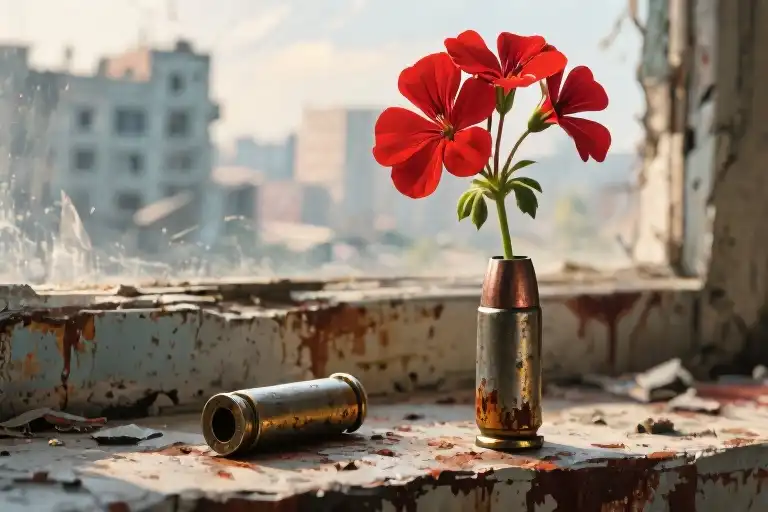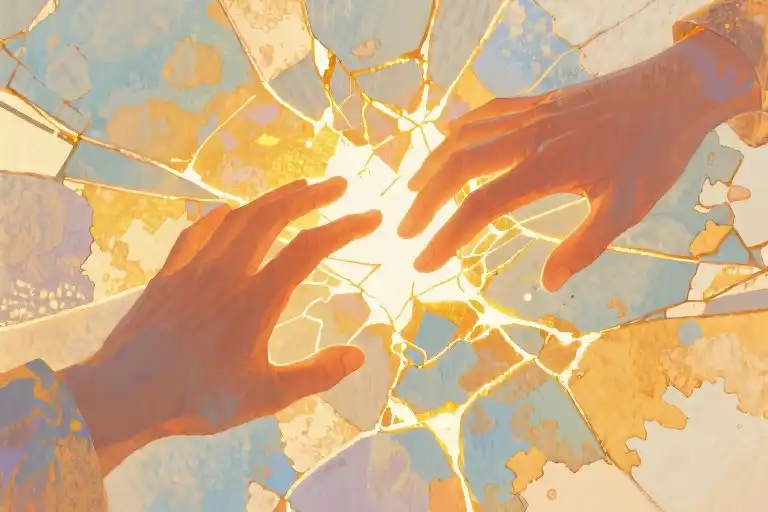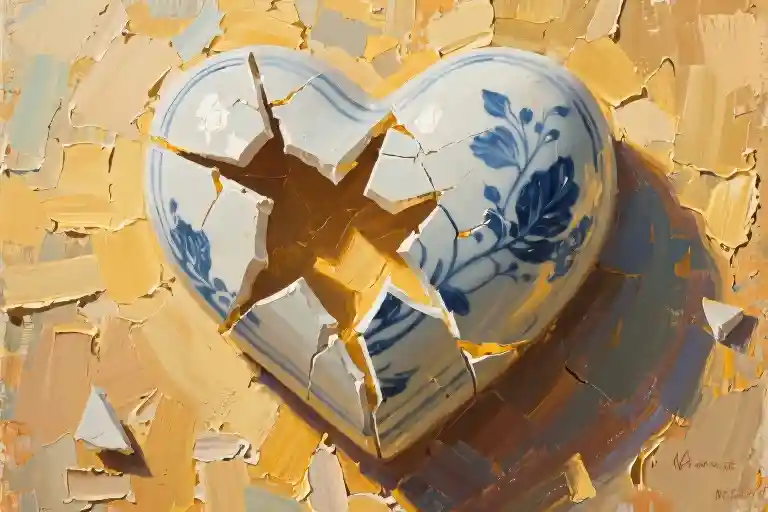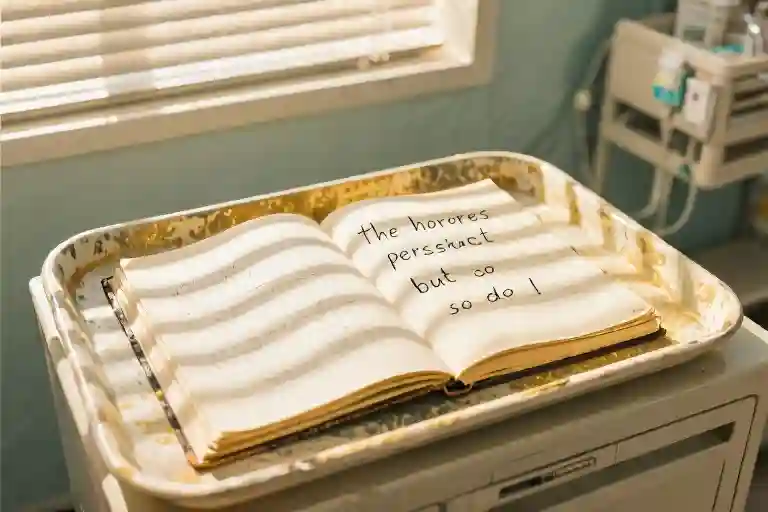The alarm clock never rings anymore. At precisely 6:03am, my eyes snap open as if pulled by invisible strings, three springs running now with this cruel punctuality. Outside my window, cherry blossoms perform their annual ballet—white petals pirouetting onto pavement still damp with dew. They should be beautiful. They would be beautiful, if not for how the morning light refracts through them like broken glass, stabbing at my sleep-deprived retinas.
I rub my temples where yesterday’s headache lingers. Third consecutive spring of this. Third spring of counting empty apartment windows across the street instead of birds on telephone wires. Third spring where the pollen in the air feels less like nature’s confetti and more like gunpowder residue clinging to my sinuses.
On the sidewalk below, a woman walks her schnauzer wearing what appears to be her entire wardrobe in varying shades of black. The dog—brown, gloriously unconcerned—stops to sniff a cluster of daffodils pushing through cracked concrete. I catch myself holding breath until they pass the intersection unharmed.
Does nature know it’s war? The magnolia tree outside City Hall blooms with obscene vigor, its pink flowers unfurling like satin gloves at a funeral. Bees bob between petals with their usual workmanlike diligence, unaware they’re pollinating flower beds flanked by sandbag barricades. At the playground, new swing chains glint in sunlight that also illuminates fresh graffiti: “Shelter →” in yellow spray paint.
My phone buzzes with a sunrise alert from a weather app I forgot to disable. The screen shows 72°F and “perfect gardening conditions” beneath yesterday’s unread message about subway station bomb shelters. I watch a petal drift onto my windowsill, its edges already browning. When I press it between pages of last year’s planner—back when we still made future appointments instead of contingency plans—the dried blossom leaves a stain like a tea ring on the March calendar square.
Three springs since the world fractured. Three springs of learning how light can hurt, how blossoms can trigger panic attacks, how the most resilient things aren’t oak trees but grandmothers who still sweep their doorsteps even when the street ends in rubble. Outside, a bumblebee bumps against my window before reorienting toward the linden trees. I wonder if its hive remembers the winters before all this began, or if like the children born since, it only knows this altered world where flowers grow through bullet casings and spring smells like fear sweating through wool coats.
My hands have developed their own spring ritual: left one massages the tension between my eyebrows, right one reaches to lower the blinds against the assault of another perfect blue-skied morning. The mechanism clicks shut with finality, but thin lines of sunlight still stripe the floorboards—persistent as hope, painful as memory.
The Paradox of Spring
The tulips in Shevchenko Park bloomed with obscene vibrancy this April, their candy-colored heads bobbing just meters from the freshly dug anti-tank trenches. Tourists would have photographed this surreal postcard last year—crème brûlée yellows against earthy fortifications—but today the only observers were crows perched on sandbags, their black feathers mirroring 87% of pedestrians’ clothing according to my compulsive sidewalk surveys.
This chromatic dissonance became my daily meditation. I’d count: one woman in navy (hope!), three in charcoal (realism), a teenager in military camouflage (prophecy?). The remaining 13% wore muted florals that seemed to apologize for their existence, like the elderly florist who still arranged peonies outside her boarded-up shop, whispering “They need beauty too” as artillery rumbled in the distance.
My body registered the season before my mind could. Pollen clung to my eyelashes like gunpowder residue, triggering sneezes that felt suspiciously like suppressed sobs. Allergies became somatic metaphors—histamines flooding my system just as anxiety flooded the city, both immune responses misfiring against perceived threats. The pharmacy shelves told our collective story: antihistamines sold out next to sedatives, their chemical structures nearly identical on the molecular level.
At the botanical garden’s abandoned greenhouse, I found the ultimate war poem: a peach tree had shattered through glass panels, its blossoms floating above shards like wedding confetti over broken vodka bottles. A groundskeeper (black overalls, yellow rubber gloves) raked the debris into orderly piles, creating a zen garden of destruction. “Trees don’t check news apps,” he remarked when our eyes met, his shears snapping off dead branches with surgical precision.
Even children’s games transformed. Near the playground’s crater, I watched a girl of about seven pluck dandelions, blowing their seeds toward the eastern districts with deliberate force. “Making wishes?” I asked. She shook her head gravely: “Sending medicine.” Her tiny hands were stained green from stripping stems, the chlorophyll seeping into her cuticles like nature’s camouflage.
These contradictions bloomed everywhere once I learned to see them—the way sunlight hit a sniper’s scope, creating brief, terrible stars; how birds nested in tank barrels, weaving twigs between cold metal grooves. The war didn’t cancel spring, it created a new hybrid season where every petal cast two shadows: one of beauty, one of threat. My therapist called this phenomenon “bifurcated perception.” The woman who sold me coffee called it “learning to hold your joy and fear in the same shaky hands.”
The Spiral of Time
I keep two lists in my notebook now. One is faded, written in happier times with ink that smudges when my fingers brush against it. The other is fresh, constantly revised in hasty pencil strokes that dig into the paper. They tell the story of how spring has changed for us.
Before:
- Wicker picnic basket (the one with blue gingham lining)
- Egg dyes in twelve colors
- New sundress with pockets deep enough for wildflowers
- Notebook for pressing blossoms
- Lemonade pitcher with matching glasses
After:
- Industrial earplugs (rated for 32dB noise reduction)
- Three portable chargers (minimum 20,000mAh)
- Blood clotting gauze (Israeli bandage style)
- Laminated evacuation routes (updated monthly)
- Ziploc bags for important documents
The contrast still shocks me when I flip between pages. That picnic basket sits abandoned in my parents’ attic now, collecting dust alongside Easter egg molds and a collection of pastel ribbons. These days, my spring preparations involve checking expiration dates on emergency supplies and memorizing the locations of underground parking garages that double as bomb shelters.
I remember teaching my niece how to dip eggs in onion skins to make golden patterns, her small hands steady with concentration. Last week, I taught her how to distinguish between artillery sounds by their pitch – a morbid game we call ‘thunder or tanks.’ She’s gotten frighteningly good at it.
When I try to imagine next spring, my mind conjures impossible scenarios. Maybe I’ll be watching cherry blossoms through the reinforced glass of a foreign consulate, filling out asylum paperwork. Perhaps I’ll wake to their petals falling on the cracked concrete of a temporary shelter, counting days until some theoretical safety arrives. The most hopeful version has me replanting my grandmother’s rose bushes in whatever patch of earth finally becomes home again.
What haunts me most are the ordinary questions without answers: Will I ever need that picnic basket again? Should I keep saving the good chocolate for holidays that no longer feel real? When we finally unpack our emergency bags for the last time, will we remember how to live without checking the sky every fifteen minutes?
Sometimes at dawn, when that relentless spring light first touches my window, I catch myself making mental notes about things that shouldn’t matter: the particular blue of a jay’s feathers, the way dew collects on dandelion clocks. Then the rational voice interrupts – why document beauty that might not survive the summer? But I keep noticing anyway. These fragile observations feel like the last thread connecting me to the person who once made lists of picnic supplies rather than medical inventories.
We measure time differently now. Not in seasons, but in intervals between sirens. Not in holidays, but in the anniversaries of attacks. Spring no longer means renewal – it’s become a countdown to the war’s next birthday, another year of this half-life between survival and living.
Yet when I pass the old botanical garden (now fortified with sandbags), I still see volunteers watering the rose bushes. The pharmacy near my apartment keeps selling out of antihistamines – not just for war stress symptoms, but for actual pollen allergies. Life, it seems, insists on complicating our tragedies with its stubborn continuity.
Perhaps that’s why I keep both lists. The before and after. The lost and the leftover. Not just to remember what was taken, but to document what endures – even if it’s just the habit of noticing spring at all.
Portraits of Resilience
At the broken bench where the playground used to be, an old man tends to his makeshift garden. Artillery shell casings, hollowed out and scrubbed clean, now cradle clusters of crimson roses. “See these thorns?” His fingers trace the serrated edges without drawing blood. “They’ve outlasted three missile strikes. Roses remember how to survive long after generals forget how to stop.” The metallic scent of rain on spent casings mingles with the perfume of Damascus blooms—a fragrance that lingers on your clothes like gunpowder residue used to.
Down the cratered street, children have invented new rules for an old game. They collect dandelion clocks from cracks in the pavement, their small hands careful not to scatter the seeds prematurely. “Make a wish,” whispers a girl in a faded sunflower dress, her knees scabbed from last week’s evacuation drill. They blow together, watching feathery parachutes drift toward the burned-out theater. Some seeds catch in the skeleton of a shattered chandelier; others sail beyond the checkpoints. The children don’t specify their wishes aloud—some spells work better when war doesn’t hear them.
I notice the red geraniums three mornings after the heaviest shelling. They perch on my neighbor’s windowsill in recycled tin cans, their fiery blossoms defiant against the building’s pockmarked facade. No note accompanies them, just six blooms nurtured in stolen moments between air raids. At dusk, I see her through the half-open curtains—a biology teacher turned volunteer medic—wiping soil from her palms before sorting bandages. The flowers tilt westward, following the sun’s dangerous arc across a sky we no longer trust.
These acts of cultivation aren’t metaphors. The roses won’t stop tank columns; dandelion fluff can’t redirect drones. Yet in the arithmetic of survival, someone has calculated that beauty warrants rationing part of their scarce resources—water carried up nine flights of stairs, daylight hours spent watching for threats instead of tending plants. Perhaps this constitutes another kind of defense strategy: remembering that living differs from merely not dying.
What fragile thing would you protect in wartime? The question lingers like pollen in the throat. Outside my window, a boy walks past carrying a cage with two canaries, their yellow feathers brilliant against his ash-gray coat. He’s moving them to the basement shelter, again. The birds continue singing as they descend into the dark.
The Red Flower at 6am
The alarm clock never rings anymore. At precisely 6am, my eyes snap open as if pulled by invisible strings, the third spring in a row this cruel punctuality steals my sleep. Through the cracked window, white cherry blossoms drift like surrender flags against a sky too blue for war. My retinas throb—this morning light feels like broken glass, yet I can’t stop staring at the neighbor’s windowsill where a single red geranium has bloomed overnight.
People still ask how we endure. They don’t understand we’ve become collectors of fragile things—the way Mrs. Lvivski across the street saves eggshells to plant marigolds, how the children at the shelter arrange dandelion heads in empty bullet casings. Yesterday I saw a soldier tuck a poppy behind his ear before heading to the front. These aren’t acts of hope, but rather receipts proving we still exist despite the arithmetic of loss.
Spring keeps its own accounting. The pollen count rises while our pharmacy shelves empty of sedatives. Birds construct nests with strands of camouflage netting. Even the memorials change—last week someone placed daffodils in the crevices of a tank barrier, their yellow trumpets mute against the steel teeth.
That geranium on the windowsill glows like a wound. Its redness shouts when everything else whispers in grays and blacks. Maybe the neighbor planted it for her son at the front, or perhaps it’s just biology insisting on its right to continue. Either way, I find myself rearranging my mornings around its presence—stealing glances while boiling water, noting how its petals tremble during artillery drills yet never fall.
How will you preserve this impossible spring? In the hollow of your collarbone where you store unshed tears? Pressed between the pages of a passport you may never use again? Or perhaps like old man Petrenko who tends roses in a helmet—watering them with half his daily ration, whispering ‘bloom where you’re planted’ to the blossoms and himself alike.
We’ve all become gardeners of the ephemeral. My contribution: this mental photograph of a red flower at 6am, its edges blurred by my uncorrected vision and the smoke from the eastern districts. The image already fading as I turn away to face another day where war and spring refuse to negotiate their coexistence.





